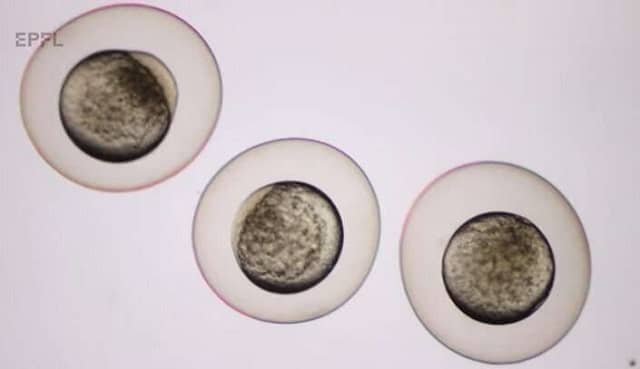by Cécilia Carron, Ecole Polytechnique Federale de Lausanne
Zebrafish eggs are among the most commonly used model organisms in genetic, developmental and toxicology research. A device developed by EPFL spin-off Bionomous cuts the time it takes to sort these embryos from several hours to just a few minutes.

Zebrafish measure just four or five centimeters in length and bear very little resemblance to human beings. So it may come as a surprise to learn that they share 70% of their genes with us. This biological characteristic, coupled with the fact that their eggs are abundant and transparent, makes these tiny freshwater minnows especially valuable to science. In fact, the past two decades have seen strong growth in zebrafish-based research in everything from myopathy and other genetic disorders to cancer, Alzheimer’s disease, drug discovery and toxicology screening. But there’s a fundamental stumbling block with this new model organism: the painstaking work of examining the eggs under a microscope to identify healthy specimens that can be used in research. EPFL spin-off Bionomous has combined microengineering and artificial intelligence to develop a machine that cuts this sorting exercise down from several hours to just a few minutes. After completing an initial fundraising round earlier this year, the company is preparing to bring its machine to market in the fall. It’s also working on a larger-capacity version of the device, which could accelerate the sorting process for other types of eggs as well as seeds.
Analyzing fluorescent fish
The benefits of using zebrafish in research first came to light around 20 years ago. Since then, many research institutions – including EPFL – have opened dedicated breeding facilities. “One key advantage of zebrafish is that they develop outside of the mother’s body from a very early stage,” says Frank Bonnet, the CEO and co-founder of Bionomous. “This makes them a more ethical choice than other models such as mice, supporting a broad range of research into the development of fish and, by extension, vertebrates.” For his thesis, Bonnet worked on developing a robotic fish capable of infiltrating flesh-and-blood zebrafish shoals. He came up with the idea for his device after watching other researchers spend hours poring over a microscope to select viable eggs.
With his PhD under his belt, Bonnet set about designing a machine that could process an entire test tube – containing thousands of eggs – in a single pass. It uses a microfluidic system to capture individual specimens, ejecting them one by one onto a notched wheel. As the wheel turns, the eggs go under a camera. The images are then processed by an artificial intelligence system: healthy specimens are pipetted onto a screening plate or into a petri dish, while rejected samples are sent to a separate container. The machine also supports fluorescent imaging in genetically modified specimens, allowing scientists to observe features such as blood vessels and neurons in real time. The deep learning algorithms can be tailored to researchers’ requirements, classifying eggs by fertilization status, developmental stage, morphological traits or specific biomarkers.
A new version in preparation for sorting other tiny entities
Since filing a patent application in 2017, the company has secured seed funding from several sources and tested their technology at a string of laboratories, including Sweden’s Karolinksa Institute, one of Europe’s biggest animal research facilities. “One of our machines is a permanent fixture at Oregon State University, which has also placed an order for several new-generation devices,” says Bonnet.
In 2021, the spin-off raised 1.3 million Swiss francs in an initial fundraising round. It used the capital injection to finalize the machine, which it will bring to market this fall. Now, the company is working on a new version to support research into other small biological entities. “In sectors such as agriculture and fish farming, researchers still spend countless hours sorting through vast quantities of eggs and seeds,” says COO and co-founder Ana Hernando. As a member of the Venture Leaders Biotech cohort, Bonnet will travel to the United States in mid-September to meet international investors and leading players in this niche market.

